Rinnai CHS199100CU User Manual
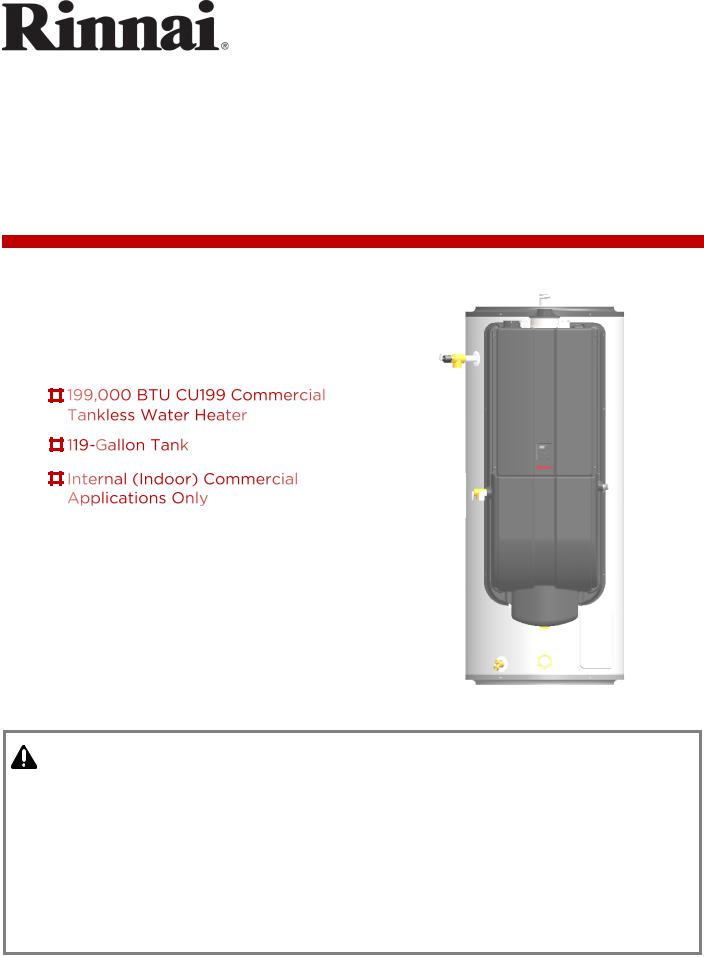
INSTALLATION AND OPERATION MANUAL
Demand Duo™
Commercial Hybrid Water Heating System
Demand Duo™ Model
CHS199100CU
|
|
|
If the information in these instructions is not followed exactly, a fire or |
|
|
|
|
||
|
|
|
||
|
|
|
||
|
|
|
||
|
|
|
||
WARNING |
||||
explosion may result causing property damage, personal injury, or death. |
||||
•Do not store or use gasoline or other flammable vapors and liquids in the vicinity of this or any other appliance.
•WHAT TO DO IF YOU SMELL GAS
−Do not try to light any appliance.
−Do not touch any electrical switch; do not use any phone in your building.
−Immediately call your gas supplier from a neighbor’s phone. Follow the gas supplier’s instructions.
−If you cannot reach your gas supplier, call the fire department.
•Installation and service must be performed by a qualified installer, service agency or the gas supplier.
Rinnai Commercial Hybrid System Installation and Operation Manual
Contents |
|
1. Welcome ......................................................... |
3 |
2. Safety .............................................................. |
4 |
Safety Symbols .................................................... |
4 |
Safety Precautions............................................... |
5 |
3. About .............................................................. |
6 |
Specifications....................................................... |
6 |
Dimensions and Connections.............................. |
7 |
4. Installation ........................................................... |
8 |
Installation Guidelines......................................... |
8 |
Typical Installation Illustrations .......................... |
9 |
Unpack the Demand Duo™ .............................. |
10 |
Choose an Installation Location ....................... |
11 |
Transporting the Demand Duo™....................... |
13 |
Earthquake Strapping Instructions.................... |
13 |
Installation Location Checklist .......................... |
14 |
5. Venting.......................................................... |
15 |
Venting Guidelines ............................................ |
15 |
Venting Installation Sequence........................... |
16 |
Termination Considerations.............................. |
16 |
Select a Vent Type............................................. |
17 |
6. |
System Plumbing ......................................... |
35 |
|
Pressure Relief Valve Requirements ................. |
35 |
|
PRV Temperature Requirements ..................... |
35 |
|
Piping Diagram for Basic Installations............... |
36 |
|
Piping Diagram for Multiple Unit Installations .37 |
|
|
Connect Water Heater to the Water Supply .... |
38 |
|
Fill the System .................................................. |
38 |
|
Condensate ....................................................... |
39 |
7. |
Gas Supply ..................................................... |
41 |
|
Connect the Gas Supply .................................... |
41 |
8. |
Power Supply................................................ |
43 |
9. |
Post-Installation Checklist ............................. |
45 |
10. Maintenance............................................... |
46 |
|
11. Appendices .................................................. |
47 |
|
|
Service/Maintenance Log.................................. |
47 |
|
Replacement Parts ........................................... |
48 |
|
Warranty ........................................................... |
49 |
12. Notes........................................................... |
51 |
|
READ AND SAVE THESE INSTRUCTIONS
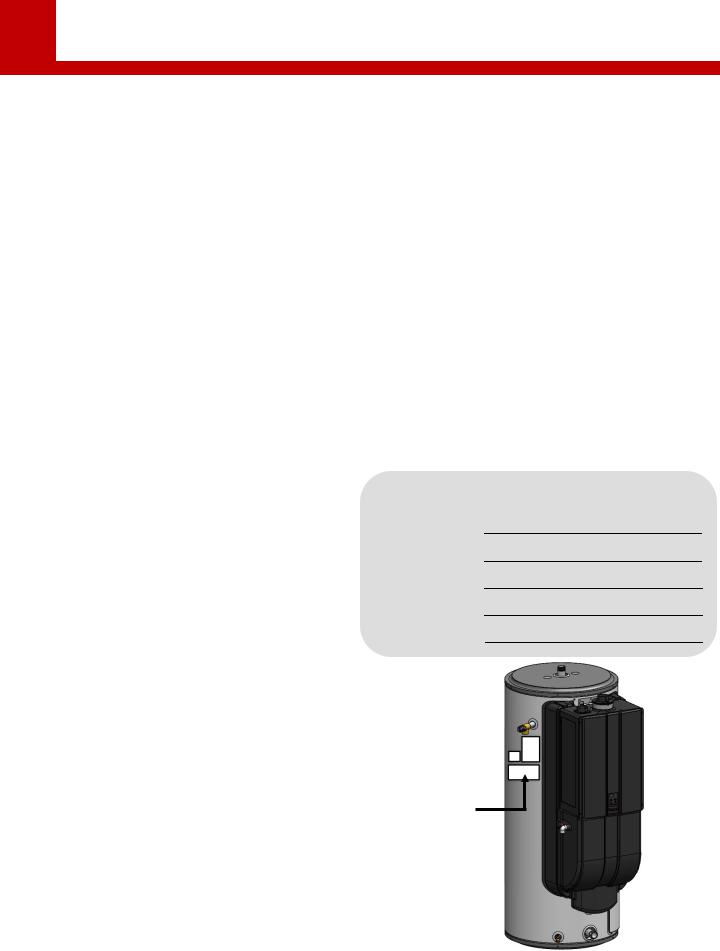
1 Welcome
Thank you for purchasing Rinnai’s Demand Duo™ Commercial Hybrid Water Heating System. This manual provides information on the installation, operation, and maintenance of Rinnai’s Demand Duo™ Commercial Hybrid Water Heating System. Read this manual completely before installing or operating the system. This manual is a supplement to the Installation and Operation Manual for Commercial CU199 Condensing Tankless Water Heaters; refer to the CU199 manual for complete water heater details, including:
•Parameter Settings (High Altitude Adjustment, Vent Length Adjustment, and more)
•Temperature Controller Installation
•Performance Data
•Diagnostic Codes
If You Need Service
Contact your local dealer/distributor or call Rinnai Customer Care at:
•Proper installation is the responsibility of the installer.
•When installation is complete, leave this manual with the system or give the manual directly to the consumer.
To The Consumer
•You must read the entire manual to properly operate the water heater and to have regular maintenance performed.
•Keep this manual for future reference.
•As when using any appliance generating heat, there are certain safety precautions you should follow. See the Safety Precautions section for detailed safety precautions.
•Be sure your water heater is installed by a licensed installer.
•If installing in the state of Massachusetts, you must read the Massachusetts State Gas Regulations section in the Installation and Operation Manual for Commercial CU199 Condensing Tankless Water Heaters (supplied with tankless water heater).
1-800-621-9419
Please have your full serial number or model number available for productor service-related issues.
To The Installer
•A trained and qualified professional must install the system, inspect it, and leak test it before use. The warranty will be voided due to any improper installation.
•The trained and qualified professional should have skills such as:
−Gas line sizing
−Connecting gas lines, water lines, valves, and electricity
−Knowledge of applicable national, state, and local codes
−Installing venting through a wall or roof
−Training in installation of tankless water heaters. Training on Rinnai Tankless Water Heaters is accessible at www.trainingevents.rinnai.us.
•Read all instructions in this manual before installing the system. The system must be installed according to the exact instructions in this manual.
For Your Records
Dealer Name:
Dealer Phone #:
Purchase Date:
Tank Serial #:
System Serial #:
System Serial
Number Label
Tank Serial
Number Label
Rinnai Commercial Hybrid System Installation and Operation Manual |
3 |
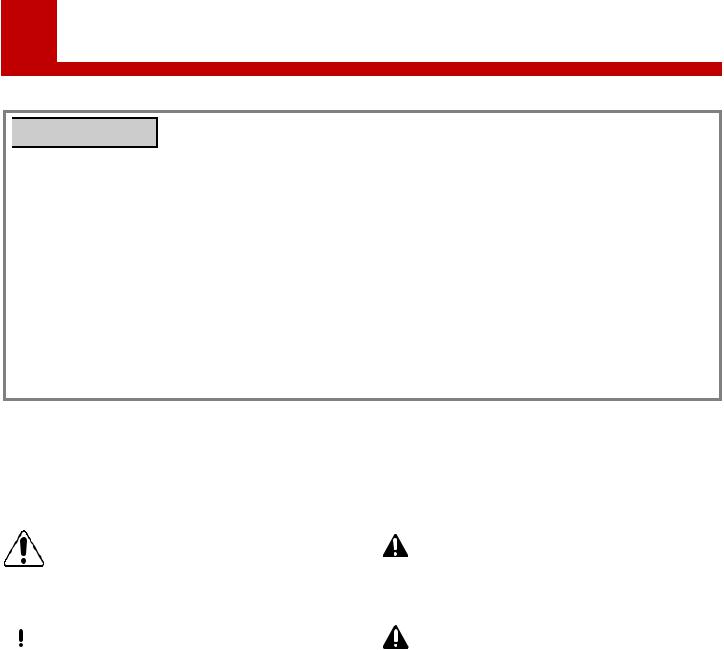
2 Safety

 WARNING
WARNING
•If the information in these instructions is not followed exactly, a fire or explosion may result causing property damage, personal injury, or death.
•Do not store or use gasoline or other flammable vapors and liquids in the vicinity of this or any other appliance.
•WHAT TO DO IF YOU SMELL GAS:
−Do not try to light any appliance.
−Do not touch any electrical switch; do not use any phone in your building.
−Immediately call your gas supplier from a neighbor’s phone. Follow the gas supplier’s instructions.
−If you cannot reach your gas supplier, call the fire department.
•Installation and service must be performed by a qualified installer, service agency or the gas supplier.
•The warning signs in this manual are here to prevent injury to you and others. Please follow them explicitly.
Safety Symbols
This manual contains the following important safety symbols. Always read and obey all safety messages.
Safety alert symbol. Alerts you to potential hazards that can kill or hurt you and others.
WARNING |
Indicates a potentially hazardous |
|
situation which, if not avoided, |
|
|
|
could result in personal injury or |
|
death. |
DANGER |
Indicates an imminently hazardous |
CAUTION |
Indicates a potentially hazardous |
|
situation which, if not avoided, will |
situation which, if not avoided, |
|||
|
|
|||
|
result in personal injury or death. |
|
could result in minor or moder- |
|
|
|
|
ate injury. It may also be used to |
|
|
|
|
alert against unsafe practices. |
4 |
Rinnai Commercial Hybrid System Installation and Operation Manual |

Safety Precautions
For proper installation, operation and safety, it is important to follow the instructions and adhere to the safety precautions shown throughout this manual. The following precautions apply to the installer and consumer.
DO NOT adjust the internal gas valve. The design is such that adjustment is not WARNING required. Warranty will be voided if the internal gas valve is adjusted.
•Before operating, smell all around the appliance area for gas. Be sure to smell next to the floor because some gas is heavier than air and will settle on the floor.
•Keep the area around the appliance clear and free from combustible materials, gasoline, and other flammable vapors and liquids.
•Combustible construction refers to adjacent walls and ceiling and should not be confused with combustible or flammable products and materials. Combustible and/or flammable products and materials should never be stored in the vicinity of this or any gas appliance.
•Always check the water temperature before entering a shower or bath.
•To protect yourself from harm, before performing maintenance:
−Turn off the electrical power supply by unplugging the power cord or by turning off the electricity at the circuit breaker. (The temperature controller does not control the electrical power.)
−Turn off the gas at the manual gas control valve.
−Turn off the incoming water supply.
−Use only your hand to turn the manual gas control valve. Never use tools. If the manual gas control valve will not turn by hand, do not try to repair it; call a trained and qualified professional. Force or attempted repair may result in a fire or explosion.
•Do not use this appliance if any part has been under water. Immediately call a licensed professional to inspect the appliance and to replace any part of the control system and any manual gas control valve which has been under water.
•Do not use substitute materials. Use only parts certified for the appliance.
•Should overheating occur or the gas supply fail to shut off, turn off the manual gas control valve to the appliance.
•Only trained and qualified professionals are permitted to adjust parameter settings.
•Do not use an extension cord or adapter plug with this appliance.
•Any alteration to the appliance or its controls can be dangerous and will void the warranty.
•Proper venting is required for the safe operation of this appliance.
•Flammable liquids such as cleaning solvents, aerosols, paint thinners, adhesives, gasoline and propane must be handled and stored with extreme care. These flammable liquids emit flammable vapors and when exposed to an ignition source can result in a fire hazard or explosion. Flammable liquids should not be used or stored in the vicinity of this or any other gas appliance.
•DO NOT operate the water heater without the front panel installed. The front panel should only be removed for service/maintenance or replacing internal components.
•BURN HAZARD. Hot exhaust and vent may cause serious burns. Keep away from the water heater. Keep small children and animals away from the water heater.
•Hot water outlet pipes leaving the water heater can be hot to touch.
•Do not store or use gasoline or other flammable vapors and liquids in the vicinity of this or any other appliance.
•Install the vent system per local and national codes.
•Do not install this water heater above 10,200 ft (3,109 m).
•Do not obstruct combustion air to the water heater.
•Failure to properly vent this appliance can result in death, personal injury and/or property damage.
•Rinnai recommends that every home have a carbon monoxide (CO) alarm in the hallway near bedrooms in each sleeping area. Check batteries monthly and replace them annually.
•California law requires the following Proposition 65 warning to be provided:
 WARNING
WARNING
This product can expose you to chemicals including lead, lead compounds and carbon disulfide which are known to the State of California to cause cancer, birth defects or other reproductive harm. For more information, visit www.P65Warnings.ca.gov.
Rinnai Commercial Hybrid System Installation and Operation Manual |
5 |
3 |
|
About |
|
|
|
||
|
|
|
|
|
|||
|
|
|
|
||||
Specifications |
|
|
|
||||
|
|
|
|
|
|
|
|
|
Model |
|
|
CHS199100CU |
|
||
|
Appliance Type |
|
Commercial Hybrid Water Heating System Consisting of Condensing Tankless |
|
|||
|
|
Water Heater, Insulated Storage Tank, Pump and Controller |
|
||||
|
|
|
|
|
|
||
|
Installation Type |
|
Internal (Indoor) Commercial Applications |
|
|||
|
Category |
|
|
Category IV |
|
||
|
Ignition System |
|
Direct Electronic Ignition |
|
|||
|
Product Weight |
|
431 lb (195 kg) |
|
|||
|
Gas Consumption Btu/hr (kW/h) |
Minimum: 15,000 (4.3) |
Maximum: 199,000 (58.3) |
|
|||
|
Water Supply Pressure |
|
150 PSI (Maximum) |
|
|||
|
Temperature Setting |
|
98° F (37° C) to 185° F (85° C) |
|
|||
|
Tank Volume |
|
119 Gallons (450 Liters) |
|
|||
|
First Hour Delivery* |
|
317 Gallons (1,200 Liters) |
|
|||
|
Sound Level |
|
|
49 dB |
|
||
|
|
|
|
Normal |
265 W |
|
|
|
|
|
|
Standby |
|
44 W |
|
|
Electrical Data |
Freeze Protection |
148 W |
|
|||
|
|
|
|
Max Current |
|
5.5 A |
|
|
|
|
|
Fuse |
Tankless Water Heater Engine: 10 Amps, Controller: 10 Amps |
|
|
|
Gas Supply Pressure** |
Natural |
3.5 - 10.5 in. w.c. |
|
|||
|
Propane |
8.0 - 13.5 in. w.c. |
|
||||
|
|
|
|
|
|||
|
By-Pass Flow Control |
|
Electronic |
|
|||
|
Connections |
|
|
Gas Supply Inlet: 3/4 in. MNPT |
Hot Water Outlet: 1-1/2 in. MNPT |
|
|
|
|
|
Cold Water Inlet: 1-1/2 in. MNPT |
|
|||
|
|
|
|
|
|
||
|
Electric Connections |
|
Appliance: AC 120 Volts, 60Hz. |
|
|||
|
|
Integrated Temperature Controller: DC 12 Volts (Digital) |
|
||||
|
|
|
|
|
|
||
|
Water Temperature Control |
Simulation Feed Forward and Feedback |
|
||||
|
Commercial ENERGY STAR® Certified (CU199i) |
|
Yes |
|
|||
|
Complies with South Coast Air Quality |
|
|
|
|||
|
Management District 14 ng/J or 20 ppm NOx |
|
Yes |
|
|||
|
Emission Levels (CU199i) |
|
|
|
|
||
|
|
|
|
|
|
|
|
*First Hour Delivery Rating is a theoretical calculation based on 70% usable tank capacity (Tank Capacity x .70 + (recovery) = First Hour Rating
**The maximum gas supply pressure must not exceed the value specified by the manufacturer.
Rinnai products are continually being updated and improved; therefore, specifications are subject to change without prior notice.
Recovery Capabilities
|
|
Input |
|
|
|
|
U.S. Gallon / HR Liters / HR at Temperature Rise Indicated |
|
|
|
||||||||||
Product |
Gas |
|
Thermal |
|
|
|
|
|
|
|
|
|
|
|
|
|
|
|
||
|
|
°F |
30°F |
40°F |
50°F |
60°F |
70°F |
80°F |
90° |
100°F |
110°F |
|
120°F |
130°F |
140°F |
|||||
|
|
|
|
|
||||||||||||||||
Number |
Type |
|
|
|
Efficiency |
Tank |
|
|||||||||||||
|
|
|
|
|
|
|
|
|
|
|
|
|
|
|
|
|
||||
|
|
BTU/HR |
|
kW |
|
Capacity |
°C |
17°C |
22°C |
28°C |
33°C |
39°C |
44°C |
50°C |
56°C |
61°C |
|
67°C |
72°C |
78°C |
|
|
|
|
|
|
|||||||||||||||
|
|
|
|
|
|
|
|
|
|
|
|
|
|
|
|
|
|
|
|
|
|
|
|
|
|
|
119 U.S. |
GPH |
780 |
585 |
468 |
390 |
334 |
292 |
260 |
234 |
213 |
|
195 |
180 |
167 |
|
NG/ |
|
|
|
|
Gals. |
|
|
|
|
|
|
|
|
|
|
|
|
|
|
CHS199100CU |
199,000 |
|
58 |
97% |
|
|
|
|
|
|
|
|
|
|
|
|
|
|
|
|
LP |
|
450 |
|
|
|
|
|
|
|
|
|
|
|
|
|
|
||||
|
|
|
|
|
|
|
|
|
|
|
|
|
|
|
|
|
|
|
||
|
|
|
|
|
|
LPH |
2,953 |
2,214 |
1771 |
1476 |
1264 |
1105 |
984 |
886 |
806 |
|
738 |
681 |
632 |
|
|
|
|
|
|
|
Liters |
|
|||||||||||||
|
|
|
|
|
|
|
|
|
|
|
|
|
|
|
|
|
|
|
|
|
|
|
|
|
|
|
|
|
|
|
|
|
|
|
|
|
|
|
|
|
|
6 |
|
|
|
|
|
|
|
Rinnai Commercial Hybrid System Installation and Operation Manual |
||||||||||||
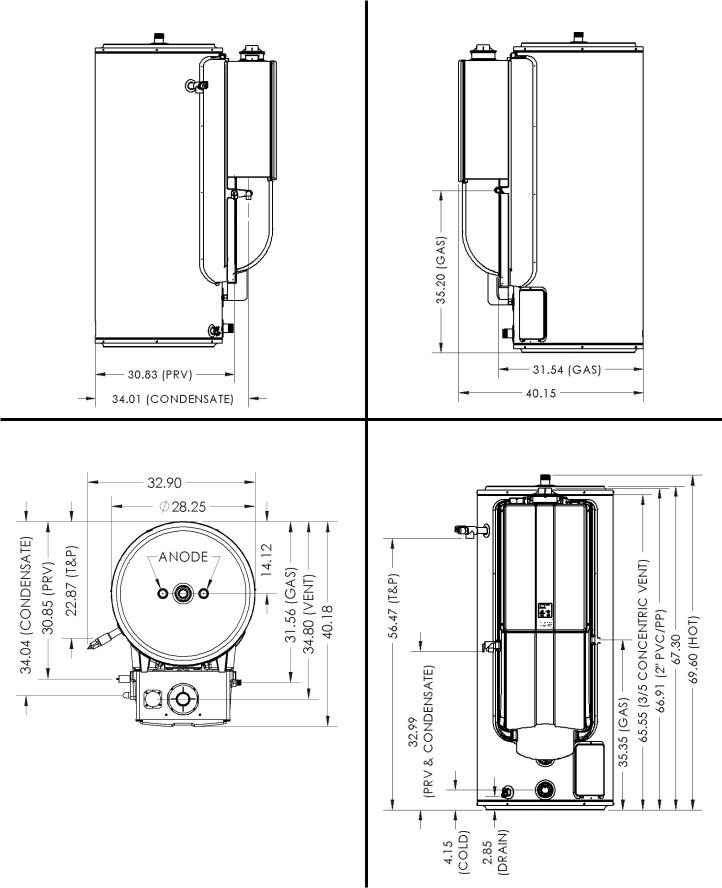
Dimensions and Connections |
Measurements in inches (in.) |
LEFT |
RIGHT |
TOP |
FRONT |
Rinnai Commercial Hybrid System Installation and Operation Manual |
7 |
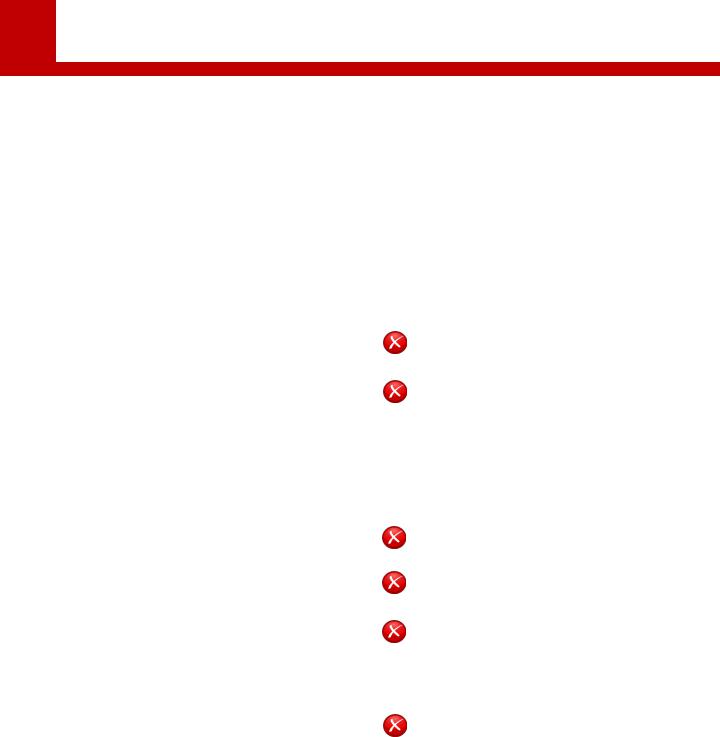
4 Installation
THIS SECTION IS INTENDED FOR THE INSTALLER
Installer qualifications: A trained and qualified professional must install the appliance, inspect it, and leak test the Demand Duo™ before use. The warranty will be voided due to any improper installation. The trained and qualified professional should have skills such as: Gas sizing; Connecting gas lines, water lines, valves, and electricity; Knowledge of applicable national, state, and local codes; Installing venting through a wall or roof; and training in installation of tankless water heaters. Training for Rinnai Tankless Water Heaters is accessible online at www.trainingevents.rinnai.us.
Installation Guidelines
When installing the Demand Duo™, follow these guidelines:
•This water heater is suitable for combination water heating and space heating and not suitable for space heating applications only.
•The installation must conform with local codes or, in the absence of local codes, with the National Fuel Gas Code, ANSI Z223.1/NFPA 54, or the Natural Gas and Propane Installation Code, CSA B149.1.
•The appliance, when installed, must be electrically grounded in accordance with local codes or, in the absence of local codes, with the National Electrical Code, ANSI/NFPA 70, or the Canadian Electrical Code, CSA C22.1.
•The appliance and its main gas valve must be disconnected from the gas supply piping system during any pressure testing of that system at test pressures in excess of 1/2 psi (3.5 kPa) (13.84 in W.C.). For system testing at pressures less than or equal to 1/2 psi (3.5 kPa) (13.84 in W.C.) the appliance must be isolated from the gas supply piping by closing its individual manual shutoff valve.
•You must follow the installation instructions and those in the venting section for adequate combustion air and exhaust.
•If a water heater is installed in a closed water supply system, such as one having a backflow preventer in the cold water supply line, means shall be provided to control thermal expansion. Contact the water supplier or local plumbing inspector on how to control thermal expansion.
•Should overheating occur or the gas supply fail to shut off, turn off the manual gas control valve to the appliance.
•Combustion air must be free of chemicals, such as chlorine or bleach, that produce fumes. These fumes can damage components and reduce the life of your appliance.
DO NOT
DO NOT install the Demand Duo™ Commercial Hybrid Water Heating System outdoors.
DO NOT install the water heater in an area where water leakage of the unit or connections will result in damage to the area adjacent to the appliance or to lower floors of the structure. When such locations cannot be avoided, it is required that a suitable drain pan, adequately drained, be installed under the water heater. The pan must not restrict combustion air flow.
DO NOT install the water heater in an area with negative air pressure.
DO NOT obstruct the flow of combustion and ventilation air.
DO NOT use this appliance in an application such as a pool or spa heater that uses chemically treated water. This appliance is suitable for filling large or whirlpool spa tubs with potable water.
DO NOT use substitute parts that are not authorized for this appliance.
8 |
Rinnai Commercial Hybrid System Installation and Operation Manual |

Typical Installation Illustrations
HOT WATER
OUTLET
A B C |
J |
|
|
||
|
COLD |
|
D |
WATER |
|
SUPPLY |
||
|
||
|
K |
|
E |
L |
|
F |
O |
|
M |
||
|
||
|
P |
|
I |
N |
|
|
||
G H |
D |
Mixing Valve Installation
R
Q
S
A |
Hot Water Outlet |
* |
|
|
|
|
|
|
B |
Hot Water Outlet Valve |
* |
|
|
|
|
|
|
C |
Cold and Hot Unions |
* |
|
|
|
|
|
|
D |
Temperature-Pressure Relief |
|
|
Valve |
|
|
|
|
E |
Operation Unit / Temperature |
|
|
Control |
|
|
|
|
F |
Temperature-Pressure Relief |
* |
|
Valve Discharge Pipe |
|
|
|
|
|
(do not cap, plug, or reduce ) |
|
|
|
|
G |
Pressure Relief Valve Discharge |
* |
|
Pipe (do not cap, plug, or reduce ) |
|
H |
Condensate Discharge Pipe (Must |
* |
|
include air gap ) |
|
I |
Drain Pan |
* |
|
|
|
|
|
|
J |
Vent pipe (PVC Room Air shown |
* |
|
for illustration purposes, see |
|
|
venting section for other options) |
|
|
|
|
K |
Gas Control Valve |
* |
|
|
|
|
|
|
L |
Gas Union |
* |
|
|
|
|
|
|
M |
Drip Leg (Sediment Trap) |
* |
|
|
|
|
|
|
N |
Cold Water Supply Valve |
* |
|
|
|
|
|
|
O |
Cold Water Supply |
* |
|
|
|
|
|
|
P |
Thermal Expansion Tank |
* |
|
|
|
|
|
|
Q |
Non-Tempered Supply Line |
* |
|
|
|
|
|
|
R |
Thermostatic Mixing Valve |
* |
|
|
|
|
|
|
S |
Non-Tempered Return Line |
* |
|
|
|
|
|
|
* Field Supplied
Rinnai Commercial Hybrid System Installation and Operation Manual |
9 |

Unpack the Demand Duo™
Items Included
Carefully unpack your system package and verify the following contents are included.
If any items are damaged or missing, contact your local dealer/distributor or call Rinnai Customer Care at 1-800-621-9419. Do not attempt to use any item that appears damaged.
Items included with system:
•Rinnai Demand Duo™ Commercial Hybrid Water Heating System
•Temperature and Pressure Relief Valve (Tank)
•Pressure Relief Valve (pre-installed on the tankless water heater)
•Installation and Operation Manual (this manual)
•2 in. PVC Vent Screens (x2) and Vent Screen Screws
What You’ll Need
Gather the recommended tools and parts before starting installation.
Items Needed (Not Included)
•Pipe wrenches (x2)
•Phillips Head screwdriver
•Adjustable pliers
•Wire cutters
•Gloves
•Safety glasses
•Level
•Soap or gas leak detector solution
•Approved venting
•Teflon tape (recommended) or pipe compound
•Pipe insulation

 WARNING
WARNING
To avoid danger of suffocation, keep plastic bags away from babies, small children and pets. Do not use these bags in cribs, beds, carriages, or playpens. The bags are not a toy.
Other Items You May Need
•Hammer drill with concrete bits
•Saw
•Threading machine with heads and oiler
•Core drill with diamond head
•Torch set
•Copper tubing cutter
•Steel pipe cutter
•Heat tape
•5/8 in. ID PVC flexible tubing
•Electrical wire
•Concrete wall anchors
•Optional pipe cover
•PVC glue/cement and primer
•2 conductor 22 AWG wire for controller
•Single gang electrical box
•Wire nuts
•Unions and drain valves
•Drain pan
•Earthquake strap
10 |
Rinnai Commercial Hybrid System Installation and Operation Manual |

Choose an Installation Location
When selecting an installation location, you must ensure that clearances will be met and that the vent length will be within required limits. Consider the installation environment, water quality, and need for freeze protection. Requirements for the gas line, water lines, electrical connection, and condensate disposal can be found in their respective installation sections in this manual.
Water Quality Guidelines
This section provides information on the importance of water quality to the Rinnai Tankless Water Heater. The information is intended to serve as general guidelines only and is not a complete list of water quality guidelines.
Consideration of care for your water heater should include evaluation of water quality. The water must be potable, free of corrosive chemicals, sand, dirt, or other contaminants. It is up to the installer to ensure the water does not contain corrosive chemicals or elements that can affect or damage the Rinnai Tankless Water Heater. Water that contains chemicals exceeding the levels below can damage the Rinnai Tankless Water Heater. Replacement of components due to water quality damage is not covered by the warranty.
Contaminant |
Maximum Level |
Total Hardness |
Up to 200 mg/L |
|
|
Aluminum * |
Up to 0.2 mg/L |
|
|
Chlorides * |
Up to 250 mg/LL |
|
|
Copper * |
Up to 1.0 mg/L |
|
|
Dissolved Carbon Dioxide (CO2) |
Up to 15.0 mg/L |
|
|
Iron * |
Up to 0.3 mg/L |
|
|
Manganese * |
Up to 0.05 mg/L |
|
|
pH * |
6.5 to 8.5 |
|
|
TDS (Total Dissolved Solids) * |
Up to 500 mg/L |
|
|
Zinc * |
Up to 5 mg/L |
|
|
* Source: Part 143 National Secondary Drinking Water Regulations
If you install this water heater in an area that is known to have hard water or that causes scale build-up, the water must be treated and may require a more frequent flushing schedule.
This water heater includes a service indicator (Service Soon, SS). When selected in the parameter settings, an SS code will display on the controller indicating that it is time to flush and service the water heater. Scale build-up is caused by hard water and can be accelerated if the water heater is set at a high temperature.
Rinnai offers Southeastern Filtration’s “ScaleCutter Water Conditioning System” that offers superior lime scale prevention and corrosion control by feeding a blend of control compounds into the cold water supply.
Environment
Air surrounding the water heater, venting, and vent termination(s) is used for combustion and must be free of any compounds that cause corrosion of internal components. These include corrosive compounds that are found in aerosol sprays, detergents, bleaches, cleaning solvents, oil based paints/varnishes, and refrigerants. The air in beauty shops, dry cleaning stores, photo processing labs, and storage areas for pool supplies often contains these compounds. Therefore, it is recommended that external (outdoor) models be used for these locations where possible. In applications utilizing room air where there are high levels of particulates, Rinnai offers a room air screen.
The water heater, venting, and vent termination(s) should not be installed in any areas where the air may contain these corrosive compounds.
Rinnai Commercial Hybrid System Installation and Operation Manual |
11 |
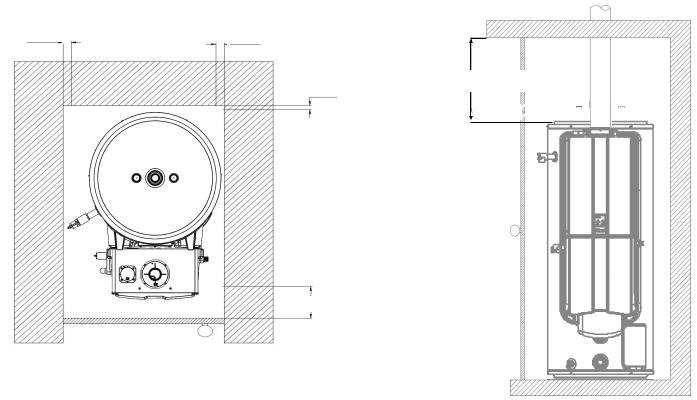
CLEARANCES
Location |
Clearance |
|
|
Top |
2 in. (51 mm) |
|
(0 in. from vent components) |
|
** Clearance for servicing the anode rods is 54 in. from the top of |
|
the water heater |
|
|
Bottom (Ground) |
0 in. |
|
|
Front |
6 in. (152 mm) |
|
* Clearance for servicing is 24 in. (610 mm) in front of water heater |
Back |
0 in. |
Sides (Left and Right) |
0 in. |
|
|
0 in. Minimum |
0 in. Minimum |
0 in. Minimum |
** 12 in. Minimum |
|
Door 
*6 in. Minimum
12 |
Rinnai Commercial Hybrid System Installation and Operation Manual |
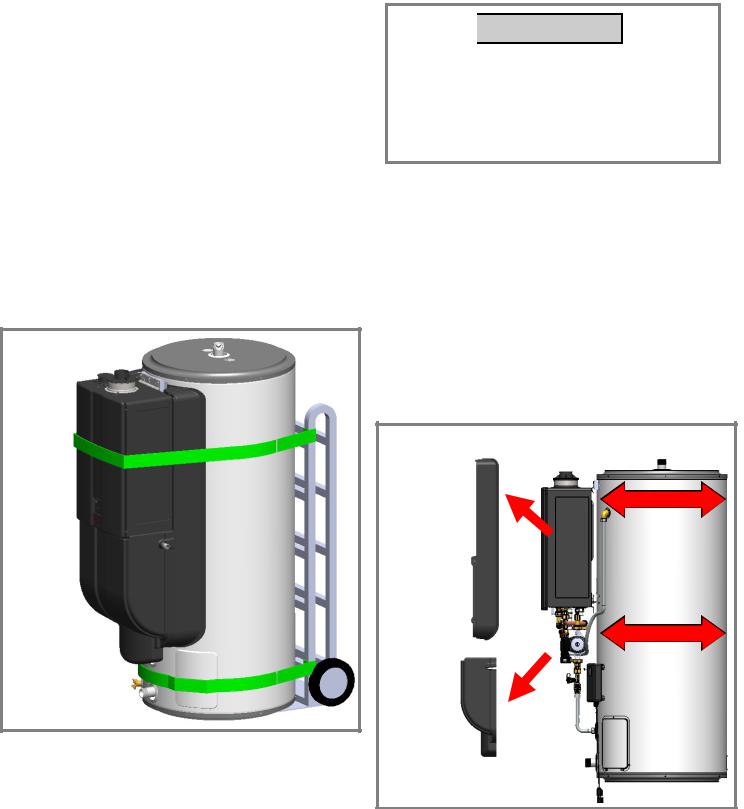
Transporting the
Demand Duo™
•Choose the right hand truck to support the weight and size of the water heater. Refer to the Specifications section in this manual for specific weights and dimensions.
•Use proper lifting techniques to load the water heater onto the hand truck:
−Position the water heater onto the hand truck so the weight is evenly balanced and the tank is touching the rails of the hand truck.
−Secure the water heater to the hand truck:
→Position STRAP A around the tankless unit as illustrated below.
→Position STRAP B around the base of the tank below the lower enclosure.
Strap A 
Lower 
Enclosure
Strap B 
Earthquake Strapping
Instructions

 NOTICE
NOTICE
Products installed in the state of California must be braced, anchored, or otherwise secured to avoid motion or falling during an earthquake. Contact the California Office of the State Architect located at 1102 Q Street, Suite 5100, Sacramento, CA 95811 for instructions.
1.Loosen the screws along the perimeter of the plastic enclosures.
2.Remove the plastic enclosures.
3.Position straps around the tank per the requirements of California Office of the State Architect. DO NOT
POSITION THE STRAPS OVER PIPE, FITTINGS or WIRE.
4.Replace the plastic enclosures. Modification of the plastic enclosures may be necessary to fit the enclosures over the earthquake straps.
5.Replace the screws around the perimeter of the plastic enclosures.
Plastic
Enclosure STRAP
(Side)
STRAP
Plastic
Enclosure
(Bottom)
Rinnai Commercial Hybrid System Installation and Operation Manual |
13 |

Installation Location Checklist
Use this checklist to ensure you have selected the correct location for the water heater.
□The water heater is not exposed to corrosive compounds in the air.
□The water heater location complies with the required clearances.
□The planned combustion air and exhaust termination locations meet the required clearances.
□The water supply does not contain chemicals or exceed total hardness that will damage the heat exchanger.
□A standard 3 prong 120 VAC, 60 Hz properly grounded wall outlet or other 120 VAC, 60 Hz source is available.
□The installation must conform with local codes or, in the absence of local codes, with the National Fuel Gas Code, ANSI Z223.1/NFPA 54, or the Natural Gas and Propane Installation Code, CSA B149.1.
14 |
Rinnai Commercial Hybrid System Installation and Operation Manual |

5 Venting

 NOTICE
NOTICE
For venting information not specified in this section, refer to the Installation and Operation Manual for Commercial CU199 Condensing Tankless Water Heaters (supplied with each tankless water heater). This manual includes complete venting information, including approved vent manufacturers and terminations.
Venting Guidelines
•When installed as direct vent, the vent system certified and listed with the appliance. You must use vent components that are certified and listed with the water heater model.
•Avoid dips or sags in horizontal vent runs by installing supports per the vent manufacturer’s instructions.
•Support horizontal vent runs every four feet and all vertical vent runs every six feet or in accordance with local codes.
•Venting should be as direct as possible with a minimum number of pipe fittings.
•Engineered vent systems must be firmly pressed together so that the gaskets form an air tight seal.
•The vent piece connected to the water heater must be secured with one self-tapping screw.
•If the vent system is to be enclosed, it is suggested that the design of the enclosure shall permit inspection of the vent system. The design of such enclosure shall be deemed acceptable by the installer or the local inspector.
•Refer to the instructions of the vent system manufacturer for component assembly instructions.
NOTICE |
If it becomes necessary to |
|
access an enclosed vent |
||
|
system for service or repairs, Rinnai is not responsible for any costs or difficulties in accessing the vent system. The warranty does not cover obtaining access to a vent system in an enclosed environment.

 WARNING
WARNING
DO NOT use cellular core PVC/CPVC.
DO NOT use Radel, ABS, or galvanized material to vent this appliance.
DO NOT cover non-metallic vent pipe and fittings with thermal insulation.
DO NOT combine vent components from different manufacturers.
DO NOT reduce the vent diameter.
DO NOT connect the venting system with an existing vent or chimney.
DO NOT common vent with the vent pipe of any other manufacturer’s water heater or appliance.
Rinnai Commercial Hybrid System Installation and Operation Manual |
15 |

Venting Installation Sequence
1.Install the water heater.
2.Determine the termination method—horizontal or vertical, concentric, or twin pipes, etc.
3.Determine proper location for wall or roof penetration for each termination.
4.Install termination assembly as described in this manual or in the vent manufacturer’s installation instructions.
5.Install air and vent piping from water heater to termination.
6.Slope horizontal exhaust run towards the water heater 1/4 in per foot. DO NOT slope combustion air pipe towards water heater.
7.Install vent supports and brackets allowing for movement from expansion, or as per vent manufacturer’s instructions or local code requirements.
8.Install vent screen (supplied with water heater) on PVC combustion air and exhaust termination elbows as illustrated below.
•Press vent screen inside of termination piece/elbow.
•Secure vent screen to the elbow with screw provided.
Termination Considerations
Check to determine whether local codes supersede the following clearances:
•Avoid termination locations near a dryer vent.
•Avoid termination locations near commercial cooking exhaust.
•Avoid termination locations near any air inlets.
•You must install a vent termination at least 12 in above the ground or anticipated snow level.
The vent for this appliance shall not terminate:
•Over public walkways.
•Near soffit vents or crawl space vents or other area where condensate or vapor could create a nuisance or hazard or cause property damage.
•Where condensate or vapor could cause damage or could be detrimental to the operation of regulators pressure relief valves, or other equipment.
Listed below are important considerations for locating vent termination under a soffit (ventilated or unventilated or eave vent; or to a deck or porch):
•Do not install vent termination under a soffit vent such that exhaust can enter the soffit vent.
•Install vent termination such that exhaust and rising moisture will not collect under eaves. Discoloration to the exterior of the building could occur if installed too close.
•Do not install the vent termination too close under the soffit where it could present recirculation of exhaust gases back into the combustion air part of the termination.
16 |
Rinnai Commercial Hybrid System Installation and Operation Manual |
